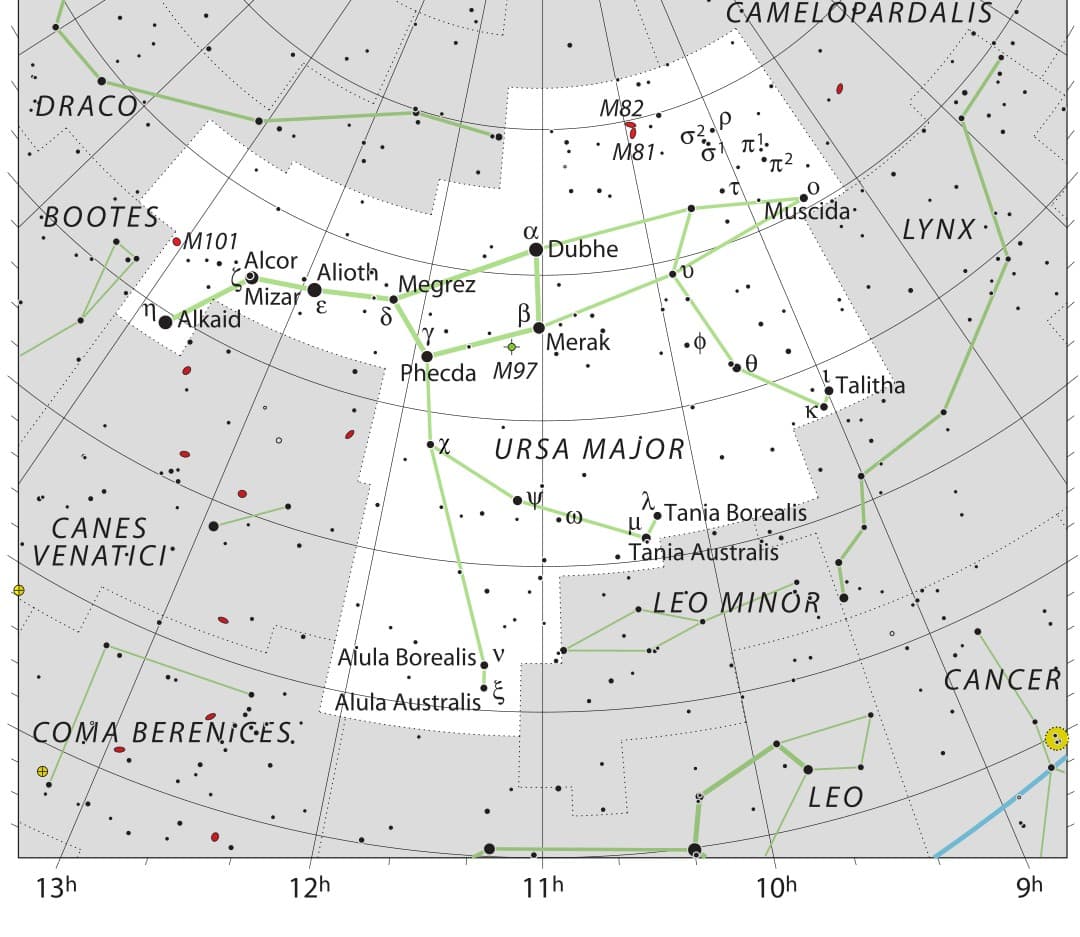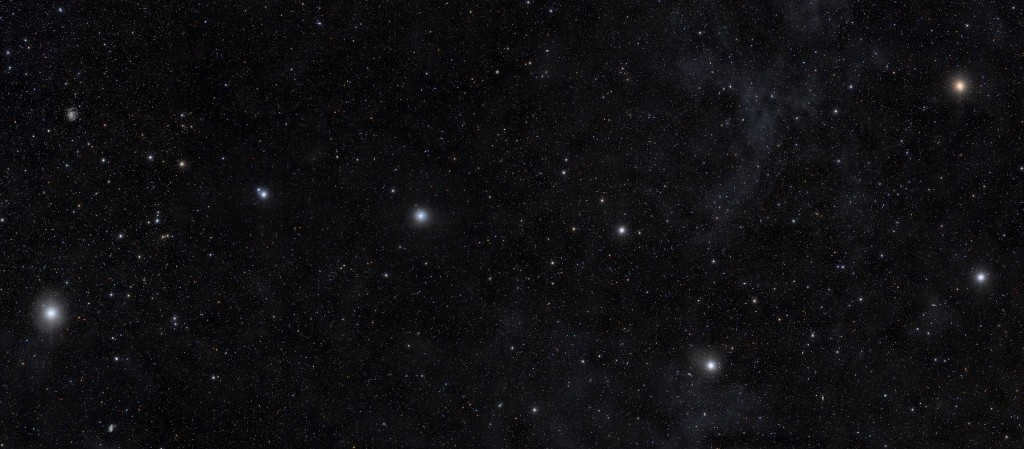
The Big Dipper constellation is one of the largest constellations in terms of area, ranking third after Hydra and Virgo. This part of the sky contains over 200 stars, and on a clear night far from city lights, up to 125 of them can be seen with the naked eye.
The stars within the Big Dipper constellation form the well-known shape of a dipper, which has made this constellation highly recognizable. These easily identifiable groups of stars are known as “asterisms”.
Variety of Names
Originally, this region of the sky was primarily associated with the Big Dipper, so many of the names that emerged were related to it:
- The Greeks referred to the constellation as “Helica,” which means “shell,” and sometimes as Arctos, which translates to “bear.” According to Greek authors, the Big Dipper served as a guide for ancient Greek navigators. In Greek mythology, Zeus transformed two Cretan nymphs into bears to protect them from Cronus. Another version of the story involves the nymph Callisto, who needed to hide from her sister and wife, Hera.
- The Sanskrit name for the constellation is “Sapta Rishi”, which translates to “seven sages”. This refers to the seven sons of the god Brahma, who are believed to be the ancestors of all beings and the actual creators of the universe. In Indian astronomy, these seven stars are referred to by the names of the sages.
- In Kazakh folklore, the constellation is known as “Seven Robbers” or “Zhetikarakshy”. According to legend, the supreme sky deity Tengri tied his two horses to the Iron Peg. The Iron stake, known as “Temirkazyk”, represents the Polar Star, while the two stars close to it (possibly Polar A and Polar B) symbolize the horses. The seven stars of the Big Bucket are depicted as robbers who constantly orbit around the horses, attempting to steal them.
- In Slavic folklore, this group of stars was known as the “Elk” constellation because it was originally linked to this majestic animal. In ancient Russia, the Big Dipper was also referred to as the “Horse on a Pin” constellation, depicting the Big Dipper as a horse pinned to Polaris, continuously revolving around it – like a horse going round a pin.
Big Bucket Celebrities
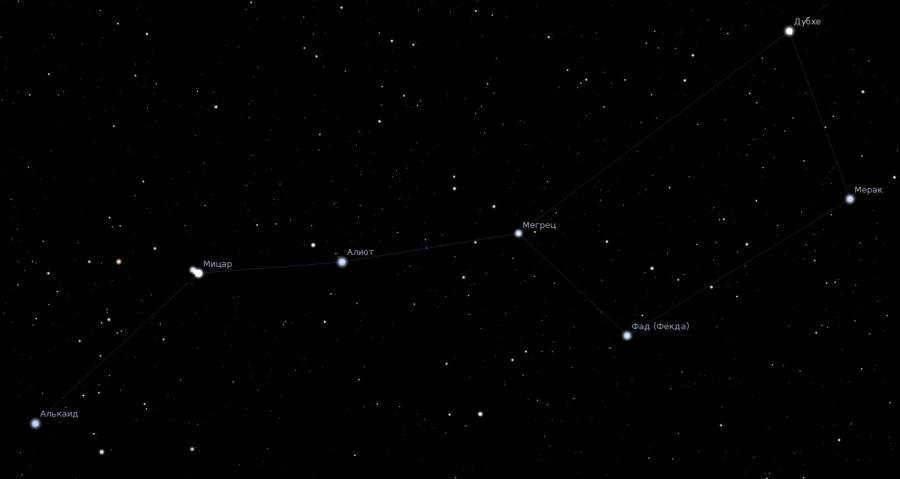
Photograph “Bucket” of the Big Dipper
The seven most prominent and largest stars in the constellation of the Big Dipper, which form the Big Bucket:
- Dubhe (Alpha of the Big Dipper) derives its name from the Arabic phrase, “the back of the big bear.” It is the second brightest star in the constellation. In fact, Dubhe is a multiple star system, consisting of three stars: an orange giant (the precursor to a red giant) and two main sequence stars.
- Merak (β) comes from the Arabic word for “loins” or “groin”. If a straight line is drawn through the stars Merak and Dubhe, extending northward, it will pass through Polaris. Therefore, these two stars are sometimes referred to as Pointers.
The Pointers to Polaris are Merak and Dubhe
- Thekda (γ) – “thigh.”
- Aliot (ε) – "curd." The most brilliant star in this constellation (with an apparent stellar magnitude of 1.76).
- Mizar (ζ) translates to Arabic as "belt". In close proximity to Mizar lies another star known as "Alcor". It is of interest to note that the ability to differentiate between these two stars is a result of exceptional eyesight (with a maximum myopia of 1 diopter). Legend has it that the ancient Egyptians would enlist young men into their army based on their ability to distinguish these two stars. Other versions suggest that it was Indian hunters or Greek archers. It is worth mentioning that a new study conducted in 2009 revealed that Mizar and Alcor actually form a sixfold system, with the twin stars Mizar A and B orbiting around the double star Alcor.
- Benetnash (η) or alternatively known as Alkaid. It is the third most luminous star in the constellation of Ursa Major. The name “Al-kaid banat nash” is derived from Arabic and translates to “leader of the mourners”. This name, portrayed as a poetic image, originates from the Arabic folk interpretation of this constellation.
- It is worth mentioning that the asterism of the Big Dipper also goes by the name “The hearse and the Mourners”. According to this depiction, the three stars form the mourners, with a leader (“Al-kaid banat nash”) leading the way, followed by the funeral procession.
On average, the stars that make up the Big Dipper are approximately 120 light-years away from Earth. These stars are not the brightest in the night sky, with an average apparent magnitude of around 2m. However, they are easily recognizable and can be located by almost anyone.
There exists a group known as the moving cluster of the Great Bear, which is primarily composed of 14 stars. 13 of these stars are located within the constellation of the Great Bear, while the remaining 5 stars are part of the Big Bucket (Merak, Fekda, Megrets, Aliot, and Mitsar). While the stars within this cluster move at a similar velocity in one direction, the other two stars within the Big Bucket (Dubhe and Benetnasha) move in the opposite direction, resulting in a noticeable distortion in the shape of the Great Bear over a span of 100,000 years.
It is worth mentioning that a new study conducted in 2009 revealed that Mizar and Alcor actually form a sixfold system, where the binary stars Mizar A and B revolve around the binary star Alcor. It is not surprising to find them in pairs or clusters, as they often form in such configurations.
Additional elements within the Ursa Major constellation
Aside from the Ursa Major constellation, there is another pattern of stars known as the Three Leaps of the Gazelle, which resembles three pairs of stars. This pattern can also be observed within the Ursa Major constellation. The pairs of stars are as follows:
- Alula North South (ν and ξ)
- Taniyah North and South (λ and μ)
- Talitha North and South (ι and κ)
In close proximity to Alupa North, there is a red dwarf star named Laland 21185. Although it cannot be seen with the naked eye, it is the sixth nearest star system to the Sun, even closer than the Sirius A and B stars.
Those who enjoy observing the night sky are likely familiar with this particular constellation which houses a galaxy known as M101, also called the Helix. Additionally, there are two other galaxies in this constellation, M81 and M82, which are believed to be the central points of the closest group of galaxies, situated approximately 7 million light-years from Earth. In contrast to these far-off celestial objects, M 97, also known as the “Owl,” is located within our own Milky Way galaxy and is much closer in proximity, hundreds of times closer, in fact. This planetary nebula, the Owl, is considered to be one of the largest in size.
Between the first and second “gazelle jump”, there lies a small yellow dwarf, resembling our Sun at number 47, which can be observed with the aid of optics. From the year 2000 to 2010, scientists have identified three gas giants orbiting around this star system. Additionally, this particular star system bears a striking resemblance to our own solar system and currently ranks 72nd on the list of potential candidates for the NASA Terrestrial Planet Finder mission, which aims to search for Earth-like planets. Therefore, this constellation holds great interest for those who are enthusiastic about astronomy.
In the year 2013 and 2016, two of the most distant galaxies, namely z8 GND 5296 and GN-z11, were discovered within this constellation. The light from these galaxies, which was captured by scientists, had traveled for 13.02 billion years (in the case of z8 GND 5296) and 13.4 billion years (in the case of GN-z11).
The flag of Alaska (on the left) and the flag of White Sea Karelia (on the right)
Undoubtedly, the most easily recognizable and widely known constellation is the Big Dipper. Specifically, it is not the complete Big Dipper itself, but rather its component – the Big Bucket – that is clearly visible in the night sky. If one carefully examines it, one can also observe a few additional stars situated below and to the right, forming the bear’s paws and head. The shape of this constellation is undeniably fascinating, as bears with such lengthy tails have never been witnessed before.
The most noticeable part of the constellation
Everyone is familiar with the Big Dipper, which is composed of seven bright stars. These stars were given peculiar names by Arab astronomers during the Middle Ages. To us, these names may sound unusual:
Although these stars appear to be evenly spaced from the ground, this is actually not the case. The seven bright stars in the Big Dipper are not equidistant from the Earth and the Sun.
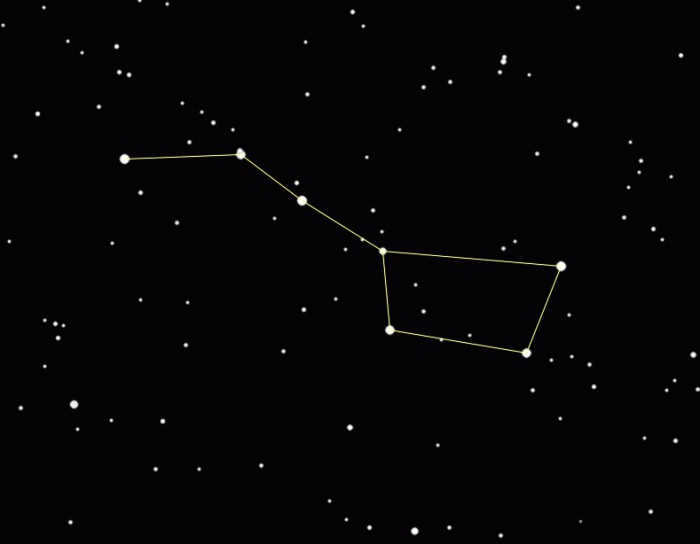
Among the stars in the constellation Ursa Major, the one closest to Earth is called Benetnash. The star farthest away from us is called Aliot, and it is located sixty light years away. Despite its distance, Aliot appears brighter than Benetnash. In fact, Aliot is the most luminous and dazzling star in the Big Dipper. In terms of the apparent brightness of their emitted light, all the stars in this part of Ursa Major are similar to stars of the second magnitude.
If you observe carefully one of the celestial bodies in the Bucket called Mitsara, you may observe a subtle pulsation adjacent to it. The reason for this phenomenon is rather straightforward. Mitsara is not an ordinary star, but rather a binary star system.
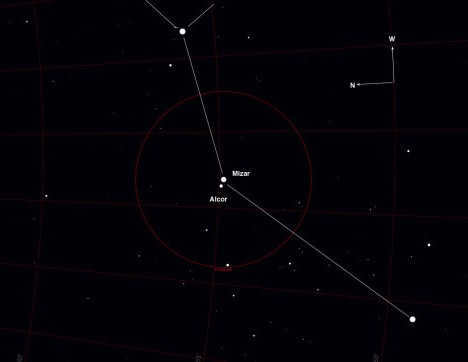

Adjacent to it is named Alcor. These two terms have their origins in Arabic and mean “horse” and “rider” respectively. Alcor and Mizar are among the most prominent binary stars observable from our planet.
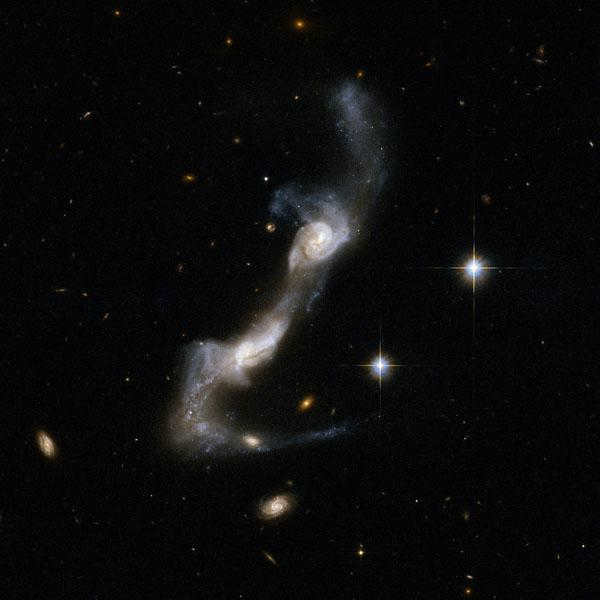
There are a total of seven bright stars in the constellation known as the Big Dipper. However, if one were to observe it through binoculars or a telescope, they would be able to spot two additional faint glimmers of light. These objects, unlike stars, appear hazy and out of focus. They resemble distant galaxies as seen from Earth. The two galaxies situated within the confines of the Big Dipper are named Whirlpool and Pinwheel.
The movement of the Ursa Major
It is common knowledge that the Earth is constantly in motion, and this movement gives the illusion that the stars in the sky are rotating. The Ursa Major is no different in this regard. During the winter and fall seasons, this prominent constellation can be found in the northern region of the night sky, positioned relatively low on the horizon. However, in spring and summer, it becomes more prominent and can be observed near the zenith. Interestingly, during this time of year, the Ursa Major appears to be inverted.
Therefore, the total count of luminous stars in the container of the notable constellation known as the Big Dipper is precisely seven. Amongst these, a pair can be utilized as a navigational aid for travelers. The essence of this proposition lies in the fact that discerning the most renowned star in existence, Polaris, becomes a straightforward task by utilizing these two stars as a guide. The process is not arduous. It merely necessitates envisioning an imaginary line that extends along the outermost stars of the bowl-shaped section of the Big Dipper. Following this, an approximate measurement of the distance between them should be taken. Polaris itself can be found positioned almost directly above the northernmost point on the Earth’s axis.
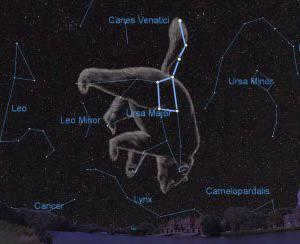
In the past, before the invention of navigation instruments, the Big Dipper constellation served as a guide for sailors and explorers. If you ever find yourself in a difficult situation in an unfamiliar area, just look at the Big Dipper. It will lead you to Polaris, the North Star, which has been a lifesaver for those lost in the wilderness, desert, or at sea. Polaris is the closest neighbor of the Big Dipper, known as the Little Dipper. Both of these constellations are located in the near-polar region according to astronomers’ classification.
How many stars are there in the Big Dipper?
There are actually many more stars in the constellation of the Big Dipper than in its most prominent part – the Bucket. Currently, there are approximately 125 known stars in total. These stars consist of over a hundred bright objects that are so dazzling that the Sun would appear small and faint in comparison. Unfortunately, the closest star to Earth is not visible to the naked eye and does not have a name. According to astronomical classification, it is classified as a 7.5 m star and it takes approximately 8.25 years for its light to reach Earth. This is almost twice as long as the closest star to us, Alpha Centauri. Therefore, the answer to the question of how many stars are in the Big Dipper is quite simple – there are over a hundred stars, and not all of them can be seen without the aid of a telescope or binoculars. To imagine seeing a wild animal with a long tail in the Bucket, one must have a vivid imagination.
The Tale of the Great Bear
Undoubtedly, when it comes to such prominent celestial objects as the stars composing the constellation known as Ursa Major, there are bound to be numerous myths and legends surrounding them. The Greeks, in particular, crafted a particularly famous legend about Ursa Major. According to the chronicles of this ancient civilization, there once existed a king in Arcadia who had a daughter of extraordinary beauty named Callisto. So confident was she in her attractiveness that she dared to challenge Hera, the wife of Zeus, herself. In response, the enraged goddess, utilizing her mystical powers, transformed the proud girl into a bear. As Callisto’s son, Arkas, returned from a hunting expedition, he encountered a wild beast at the entrance of the palace and intended to kill it. However, at the last moment, Zeus himself intervened, as he was captivated by the beauty. After her rescue, Callisto was elevated to the heavens, becoming the stars of Ursa Major. Simultaneously, the supreme god also elevated Callisto’s beloved canine companion to the celestial realm, where it is now known as the Little Bear.
The stars in the group of stars known as the Big Dipper, or more specifically in its Bucket, are the most easily visible in the sky at night. However, apart from the constellation of the Little Bear, there are also several other famous groups of stars in the vicinity. The same Polaris can serve as a point of reference for locating one of them. Behind it, on the opposite side of the Big Dipper, at roughly the same distance, lies Cassiopeia, which is familiar to many by its name. In appearance, this group of stars resembles the Cyrillic letter “И”. Depending on the position of the Earth, Cassiopeia “flips” and takes the shape of the Latin letter W.
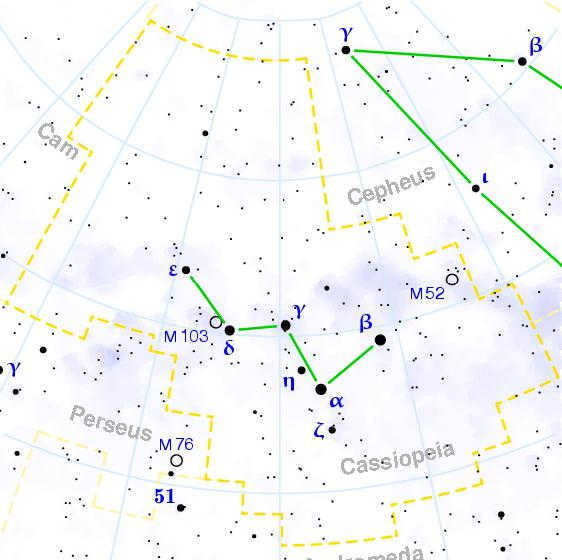
Between the Big Dipper and the Little Dipper, one can observe the constellation Cepheus, which is not as prominent but still widely recognized. It lacks a distinct shape that is easily recognizable. Connecting the Big and Little Dipper, one can also spot the winding Dragon. Its stars form a chain that can be traced on a map with a broken line.
So, we trust that we have provided a satisfactory answer to the main inquiry of this article regarding the number of radiant permanent objects in the Big Dipper. In the Dipper, there are only seven. The primary constellation consists of approximately 125 distant “suns”.
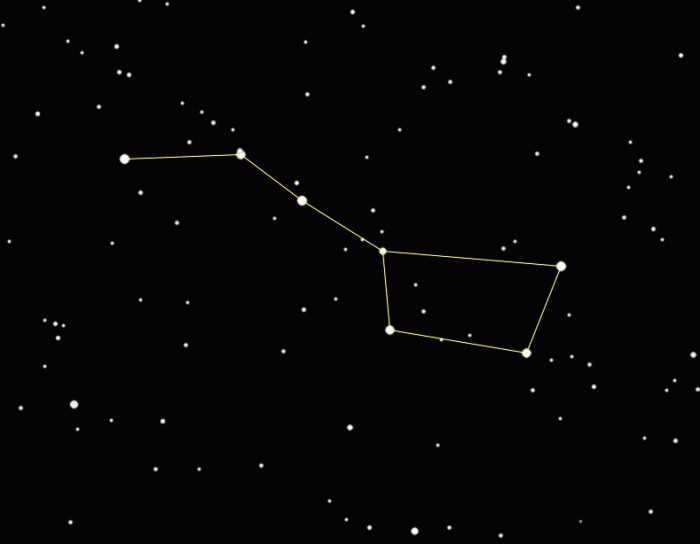
The most well-known constellation, known to everyone without exception, is undoubtedly the Big Dipper. Specifically, it is not actually the Big Dipper itself, but rather a part of it – the Big Bucket – that is easily visible in the night sky. Upon closer inspection, one can also observe a few additional stars below and to the right, which form the bear’s paws and head. The shape of this constellation is truly captivating, as bears with such long tails have never been seen before.
The most prominent part of the constellation
Everyone can easily observe the constellation known as the Big Dipper and count its bright stars, which total seven. These stars were named by Arabian astronomers during the medieval period.
However, their names may seem peculiar to us:
- Merak.
- Mizar.
- Fegda.
- Megretz.
- Dubge.
- Aliot.
- Benetnash.
Although these stars may appear to be equidistant from the ground, in reality, they are not evenly spaced. The seven bright stars in the Big Dipper are located at varying distances from both the Earth and the Sun.

Benetnash is the nearest star to our planet. Aliot, on the other hand, is located sixty light years away, but it appears brighter than Benetnash. It is the most luminous and dazzling entity in the Big Dipper. All the stars in this section of the constellation have an apparent brightness similar to that of 2nd magnitude stars.
If you observe carefully the Bucket’s star, Mitsar, you will notice a subtle flicker in its vicinity. The reason behind this phenomenon is quite straightforward. Mitsar is not your average star; it is actually a binary star system.
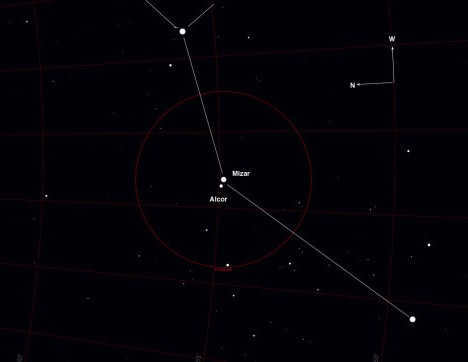
The celestial body adjacent to it goes by the name Alcor. These two terms are translations from the Arabic language, meaning “Horse” and “Rider” respectively. Alcor and Mizar comprise one of the most easily observable binary star systems when viewed from our planet.
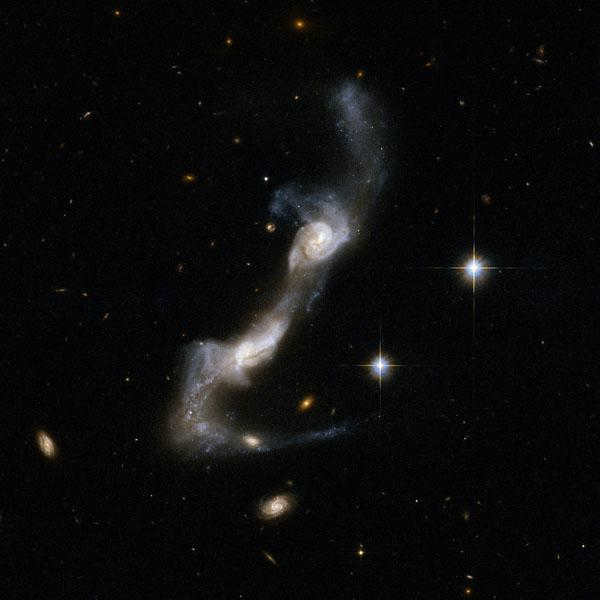
In the constellation of the Big Dipper, there are a total of seven bright stars located in the bucket. However, if you observe it through binoculars or a telescope, you may notice two additional faint spots of light. Unlike the stars, these spots appear fuzzy and blurred, resembling distant galaxies as seen from Earth. Specifically, the galaxies within the Big Dipper are known as the Whirlpool and Pinwheel galaxies.
The Revolution of the Enormous Pail
It is a well-known fact that our planet, Earth, is in constant motion and does not remain stationary. This movement gives the illusion that the stars in the sky are spinning. The Pail follows a similar pattern. During the winter and fall seasons, the Big Dipper can be found in the northern part of the night sky, positioned relatively low on the horizon. However, in spring and summer, this prominent constellation can be seen nearly at its highest point in the sky. During this time of year, the Big Dipper appears to be upside down.
Therefore, the quantity of luminous stars in the container of the prominent constellation Ursa Major – precisely seven. A pair of them can function as a navigational aid for individuals who are traveling. The key idea is that it is not challenging to locate the most renowned star globally – Polaris. This task can be easily accomplished. It simply requires envisioning an imaginary line that extends along the two outer stars of the bowl-shaped region of Ursa Major. Subsequently, one must estimate the approximate distance between them. Polaris, itself, is situated nearly directly above the geographic North Pole.
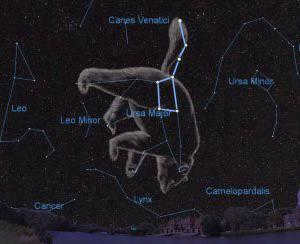
In ancient times, before the invention of navigational instruments, the Big Dipper served as a guide for sailors and explorers. If you ever find yourself in a difficult situation in an unfamiliar area, simply look up at the Big Dipper constellation. It will lead you to Polaris, the North Star, which can help you find your way. Polaris, although small and not very bright, has been a valuable guide for those lost in the taiga, desert, or at sea. It is the closest neighbor to the Big Dipper, also known as the Little Dipper. Astrologers consider the area where these two constellations are located to be near the pole.
What is the number of stars in the constellation known as the Big Dipper?
Undoubtedly, within this particular constellation, there exists an even greater number of stars than in its most prominent component, known as the Bucket. Presently, it is estimated to consist of approximately 125 stars. This amounts to over a hundred brilliant entities, surpassing the Sun in size and emitting a faint luminous glow. Regrettably, the nearest star to our planet remains invisible to the naked eye and lacks a designated name. According to astronomical categorization, it is classified as a 7.5-magnitude star. It takes roughly 8.25 years for light from this star to reach Earth, almost twice as long as the closest star to us, Alpha Centauri. Hence, the answer to the inquiry regarding the number of stars in the Big Dipper is quite straightforward – there are more than a hundred, and not all of them are perceptible without the aid of a telescope or binoculars. To envision a mythical creature with an elongated tail within the confines of the Bucket, one must possess a vivid imagination.
The closest constellations
The stars in the constellation of the Great Bear, or more precisely in its Bucket, are the most easily recognizable in the night sky. However, aside from Ursa Minor, there are several other distinctive constellations in the vicinity. The same Polaris can serve as a reference point for locating one of them. Behind it, on the opposite side of the Great Bear, at approximately the same distance, lies Cassiopeia, known by many by its name. From an external perspective, this constellation resembles the Cyrillic letter “M”. In certain positions of the Earth, Cassiopeia “inverts” and takes on the shape of the Latin letter W.
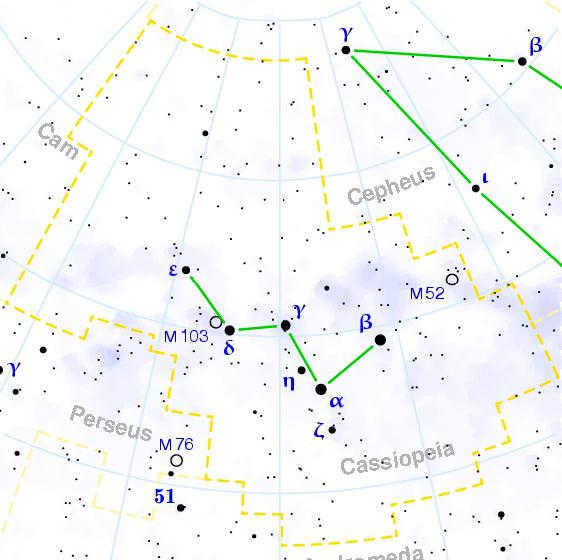

Located between the Little Dipper and the Big Dipper, one can observe the constellation Cepheus, which is not particularly noticeable, but also not unfamiliar. It lacks a distinct recognizable form. In the space between the Big Dipper and the Little Dipper, the serpentine Dragon can be easily spotted. The stars of this constellation are connected on the map by a broken line.
So, we trust that we have adequately addressed the primary inquiry raised in this article regarding the number of luminous celestial bodies present within the Big Dipper. There are only seven in the Bucket. The principal constellation consists of approximately 125 distant “suns”.
Make sure to follow our UFO World Telegram channel!
Get instant alerts on your phone whenever new articles are published
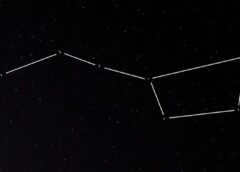
The star group known as the Big Dipper is a prominent feature in the constellation of the Big Dipper. It consists of seven bright stars and is easily recognizable in the night sky. This collection of stars has been given various names in different cultures, including the Plow, Great Cart, Saptarishi, and Pot.
An asterism is a group of stars that is not officially recognized as a constellation. The Big Dipper, for example, is an asterism within the constellation of the Big Dipper and can even extend beyond the boundaries of that constellation.
There are seven stars that form the constellation known as the Big Dipper. These stars are named Alkaid (Eta of the Big Dipper), Mizar (Zeta of the Big Dipper), Aliot (Epsilon of the Big Dipper), Megre (Delta of the Big Dipper), Fekda (Gamma of the Big Dipper), Dubhe (Alpha of the Big Dipper), and Merak (Beta of the Big Dipper).
The Big Dipper is a constellation that can be seen throughout the year in most parts of the northern hemisphere. It is considered a circumpolar constellation, which means it never goes below the horizon. As the Earth rotates, the Big Dipper slowly moves counterclockwise around the north celestial pole.
For most people, the Big Dipper is always visible in the northern half of the sky. Depending on the season, it may appear in the northeast, northwest, or directly north in the evening. From locations in the far north, it can be seen higher above the horizon compared to places in northern equatorial latitudes.
For observers in the northern hemisphere, the Big Dipper is seen in the northeast. During the spring season, it is situated high in the northeast around 10 pm and moves across the sky throughout the night.
In the summer months, the Big Dipper can be spotted above the northwestern horizon with its handle pointing upwards. As the evening progresses, it gradually moves closer to the horizon. In the fall, it appears low above the horizon in the northern part of the sky.
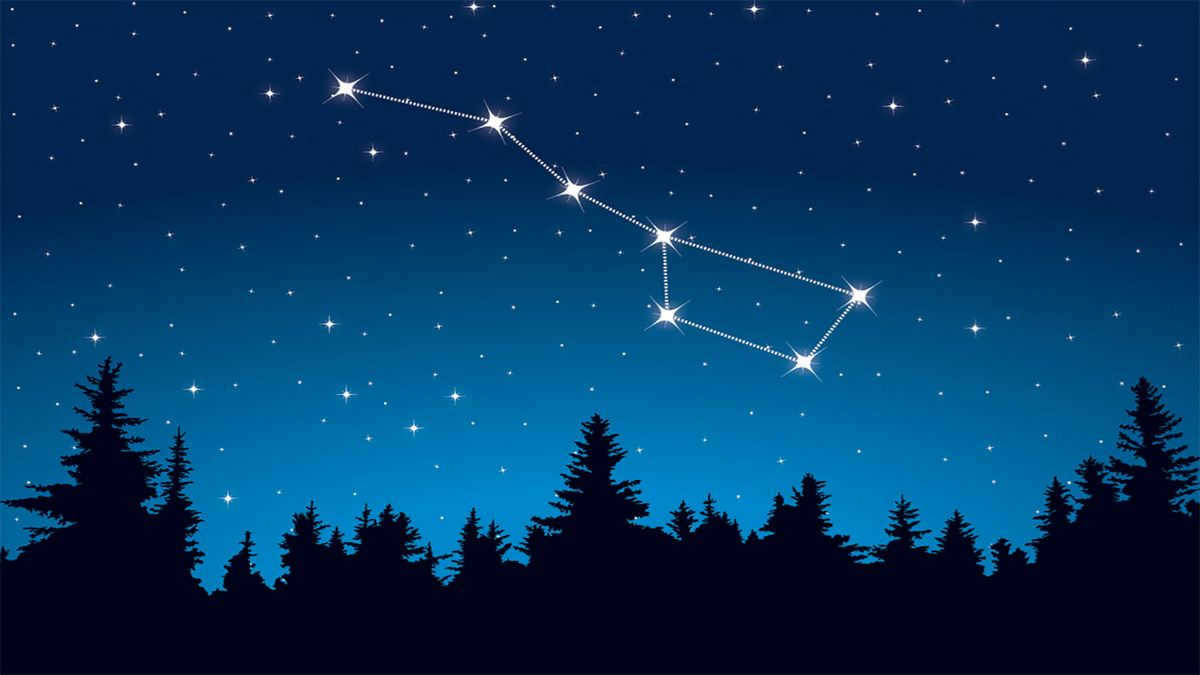

Due to its position in the far north of the sky, the Big Dipper constellation is mostly invisible to observers in the southern hemisphere. However, it can be observed from locations near the equator during the spring months, when it appears in the evening sky above the northern horizon in an inverted configuration.
Ursa Minor and Ursa Major
Ursa Minor is located in the same part of the celestial sphere as Ursa Major. It is comprised of the seven most luminous stars within the constellation of the Little Bear. Nevertheless, the four intermediate stars within the constellation are comparatively faint and challenging to observe from an urban environment. Consequently, the stellar arrangement does not prominently stand out in the night sky, and the brilliant stars of Ursa Major are typically utilized to locate it.
Stellar Constellation
The constellation known as the Big Dipper is composed of a group of seven stars:
- Alkaid, also referred to as Eta of the Big Dipper
- Mizar, also known as Zeta of the Big Dipper
- Aliot, which is Epsilon of the Big Dipper
- Megreux, commonly referred to as Delta of the Big Dipper
- Fekda, also known as Gamma of the Big Dipper
- Dubhe, commonly referred to as Alpha of the Big Dipper
- Merak, also known as Beta of the Big Dipper
What the configuration of the Big Dipper looks like
The handle of the Big Dipper, also known as the tail, is formed by Alkaid, Mizar, and Aliot, while the bowl, or back, is outlined by Megrez, Phecda, Dubhe, and Merak.
Among the seven stars that make up the Big Dipper, five belong to the movable cluster known as Colinder 285. This cluster, also referred to as the Big Dipper association, consists of stars that share the same proper motion and velocity in space. This suggests that they originated from the same molecular cloud and formed around the same time. The cluster includes the white class A stars Mizar, Aliot, Megrez, Phecda, and Merak. However, the blue main-sequence star Alcaide (class B) and the orange giant Dubhe are not part of this cluster.
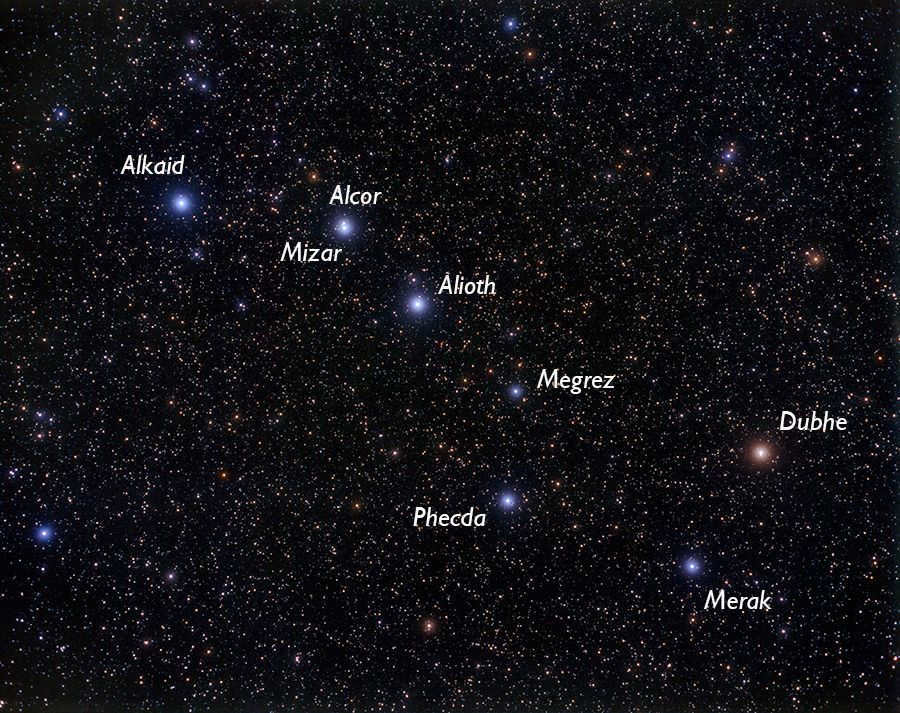
The Big Dipper constellation was formed approximately 300 million years ago and its central core is located around 80 light-years away from our planet. Additionally, many other prominent stars outside of the Big Dipper are believed to be part of this stellar association.
Alkaid
Alkaid, also known as Eta Ursae Majoris (η Uma), serves as a celestial marker for the termination of the arm of the Big Dipper as well as the tip of its tail. This star is one of the most scorching ones that can be observed without the aid of telescopes. Alkaid is considered to be a relatively young celestial body, with an estimated age of only 10 million years.
Among the stars within the Big Dipper, Alkaid ranks as the third brightest, and overall, it is the 38th brightest star visible in the night sky. It is classified as a hot blue main-sequence star of spectral type B3V. With an apparent magnitude of 1.86, Alkaid is situated approximately 103.9 light-years away from Earth.
Alkaid is 3.4 times larger, 6.1 times more massive, and 594 times brighter than our Sun. It has a surface temperature of approximately 15,540 K.
The name Alkaid derives from the Arabic term meaning “leader”. In traditional terms, Eta Ursae Majoris was also known as Benetnash.
Mizar
Mizar, also referred to as ζ UMa, is the middle star of the handle of the Big Dipper. It has a visible magnitude of 2.23 and is located about 82.9 light-years away. It was the first double star to be captured in a photograph in 1857.
Mizar is the fourth brightest star in the Big Dipper and the 69th brightest star in the night sky. It serves as the primary component of a multiple star system, which consists of two spectroscopic double stars. It forms a visual double star with the fainter Alcor, and they may be physically associated. These two stars are sometimes referred to as the Horse and Rider.
Alcor has a faint companion, and if it is gravitationally bound to Mizar, it would make Zeta of the Big Dipper a system with six stars. Both Mizar and Alcor are part of the moving group of the Big Dipper.
Mizar is the main star of the Zeta UMa system, and it is a white main-sequence star with a spectral type of A2Vp. It has a mass that is 2.2224 times that of the Sun and a radius that is 2.4 times that of the Sun. With a surface temperature of approximately 9,000 K, it has a luminosity of 33.3 times that of the Sun. Scientists estimate that the star is around 370 million years old.
Aliot
Aliot, also known as Epsilon of the Big Dipper (ε UMa), is a star located in the tail of the Big Dipper, which is the closest star to the body of the bear. It has a visual magnitude of 1.77 and is approximately 82.6 light-years away. Classified as A1III-IVp kB9, Aliot is a white star that is approaching the end of its main sequence.
With a mass of 2.91 solar masses, Aliot is 4.14 times larger than the Sun. It has a luminosity of 102 solar magnitudes and an effective temperature of around 9,020 K. The star is estimated to be around 300 million years old.
Aliot is an intriguing star that exhibits variations in its spectral lines over a period of 5.1 days. It is categorized as an Alpha2 variable of Canum Venaticorum. Moreover, Aliot is the most prominent star among the seven stars that form the well-known asterism of the Big Dipper.
Megrez
Megrez, also known as Delta Ursa Majoris, is the least bright among the seven stars that form the famous Big Dipper constellation. It is positioned at the center of the Dipper’s “bowl”, closest to its tail. Its apparent magnitude is measured at 3.312, and it lies approximately 80.5 light-years away from us.
Despite its position within the Big Dipper, Megrez is not one of the brightest stars in the constellation. It is outshone by several other stars, including Psi Ursa Majoris, also known as Tania Australis, Mu Ursa Majoris or Tania Borealis, Theta Ursa Majoris, and Iota Ursa Majoris or Talitha, which are located in different parts of the Dipper.
Megrez is classified as a white main-sequence star of spectral type A3 V. It possesses a mass equivalent to 1.63 times that of our Sun and a radius that is 1.4 times larger. With a surface temperature of approximately 9480 K, it shines about 14 times brighter than our Sun. Megrez also stands out for its fast rotation, with a projected rotation rate of 233 km/s. Like its fellow stars in the Big Dipper, it is estimated to be around 300 million years old.
Phecda
Phecda, also known as Fekda or Gamma of the Big Dipper (γ UMa), is classified as an A0Ve star, indicating that it is a main-sequence white dwarf. With a mass of 2.94 times that of the Sun and a radius 3.04 times that of the Sun, Phecda shines 65.255 times brighter than our Sun. Its effective temperature is approximately 9,355 K. Another traditional name for Phecda is Fad.
Phecda has a companion star that is an astrometric double. This companion is an orange dwarf with a spectral type of K2 V. The gravitational influence of the companion causes Phecda to oscillate around a common center of mass. The two stars have an orbital period of 20.5 years. The companion has a mass of 0.79 times that of the Sun and a surface temperature of 4,780 K, making it much cooler than Phecda. The companion also has a solar luminosity of only 0.397.
Located approximately 83.2 light-years away from Earth, Phecda has an apparent stellar magnitude of 2.438. It is the sixth brightest star in the Big Dipper.
Dubhe
Dubhe, also known as Alpha Ursae Majoris (α UMa), has an apparent magnitude of 1.79 and is located approximately 123 light-years away from Earth. It is the second most luminous star in the constellation Ursa Major, following Alioth.
Dubhe is classified as an orange giant star with a spectral type of K0III. It is a binary star system, with a white main-sequence companion of spectral type F0V. More recent sources have reclassified Dubhe as a yellow giant star of spectral class G9III, and its companion as a star of class A7.5. The two stars are separated by a distance of 23 astronomical units and have an orbital period of 44.45 years.
Dubhe is approximately 3.44 times more massive than the Sun and shines with a luminosity 165.1 times greater. It has a relatively slow rotation speed of 2.6 km/s. The companion star is less massive, with a mass of about 1.6 times that of the Sun. Its visual magnitude is 4.86.
Merak
Merak, also known as Beta Ursae Majoris (β UMa), is a subgiant star located in the constellation Ursa Major. It belongs to the spectral type A1IVps and appears as a white star. With a magnitude of 2.37, Merak is quite bright and can be easily seen from Earth. It is located approximately 79.7 light-years away from us.
Merak is classified as a suspected variable star, meaning that its brightness may vary over time. Scientists have observed fluctuations in its luminosity, although further research is needed to confirm this variability.
This star is quite massive, with a mass of 2.7 times that of our Sun. It also has a larger radius, measuring about 3.021 times the size of the Sun. At its surface, Merak has a temperature of 9,377 K, making it much hotter than our Sun. As a result, it shines with a brightness that is 63.015 times greater than that of the Sun.
Based on its characteristics, scientists estimate that Merak is approximately 500 million years old. This makes it relatively young compared to other stars in the universe.
Stars in the Big Dipper with their Arabic Names
The stars in the Big Dipper have names that originate from Arabic and primarily denote their positions in the constellation. Dubhe, for instance, is derived from the Arabic phrase żahr ad-dubb al-akbar, which means “the back of the Big Dipper”. Merak, on the other hand, comes from al-maraqq, signifying the sacrum. Aliyot’s name is derived from alyat al-hamal, which translates to “the fat tail of the sheep”. Feqda is derived from fakhth al-dubb, meaning “thigh of a bear”, while Megrez originates from al-maghriz, which means “base (of a bear’s tail)”.
The name Mizar, on the other hand, means “cover” and is derived from a misinterpretation of the word “loins”. It is connected to Mizar’s neighboring star in the Big Dipper, Merak.
Engaging Information about the Ursa Major Constellation
A standout amongst the most captivating realities about the Ursa Major constellation is its brightest star, Aliot, otherwise called Epsilon of the Big Dipper. Not exclusively is Aliot the most brilliant star in the Big Dipper, yet it is likewise the 32nd brightest star in the whole sky. Following intently behind Aliot is Dubhe, the second brightest star and Alpha of the Big Dipper. While Dubhe is marginally fainter than Aliot, it is as yet a striking star, positioning as the 34th brightest star in the sky. Both Aliot and Dubhe are basic in celestial navigation, as they are utilized to find Polaris, otherwise known as the North Star, and the north celestial pole. Their unmistakable quality and brilliance make them incredibly helpful for explorers and mariners navigating through the celestial world.
Despite being the brightest star in the constellation, Aliot goes by the Bayer designation Epsilon Ursae Majoris. Johann Bayer, a German uranographer, introduced the system of star designations that is still in use today in his stellar atlas Uranometria (1603). He assigned Greek letters to stars based on their magnitude rather than their brightness. In the case of the Big Dipper, he assigned letters from west to east. This is why Dubhe, the westernmost bright star in the constellation, is labeled Alpha. Merak, another star that helps point the way, is Beta, and Aliot, located in the handle of the Big Dipper, is Epsilon.
Out of the seven stars in the Big Dipper, five belong to the same family known as the Big Dipper association. These stars travel together through the cosmos. As a result, the middle part of the asterism will remain relatively unchanged even thousands of years from now.
Mythology of the Big Dipper
The Big Dipper holds a significant place in various cultures and their narratives. In Hindu astronomy, it is referred to as Saptarishi, meaning the Seven Great Sages. In East Asia, it is known as the North Bear (Beidou in China, Hokuto Shichisei in Korea). The Chinese also associate the seven stars with the Government, or Cei Xing. In Malaysia, it is called Buruj Biduk, meaning the Bucket, and in Mongolia, it is known as the Seven Gods.
The ancient Arabic history holds a fascinating legend regarding the Constellation of the Big Dipper. According to the tale, the stars forming the bowl symbolize a coffin, while the three stars representing the handle symbolize mourners following it. The star named Alkaid (or Benetnash) derives its name from this captivating story.
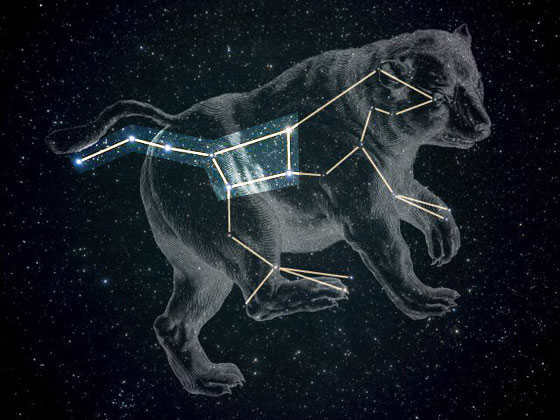
The connection between the Big Dipper and the bear has been observed by various civilizations throughout history. The bear has often been seen as a representation of this celestial formation. One well-known legend originates from Greek mythology, which links the constellation to the nymph Callisto. According to the story, Callisto was pursued by Zeus and was ultimately transformed into a bear by his wife Hera due to her jealousy.
The myth continues with Callisto giving birth to a son named Arcas, who later became a hunter and the king of Arcadia. While out hunting, Arcas encountered a bear and, not recognizing it as his mother, prepared to kill it with an arrow. However, Zeus intervened and transformed both mother and son into two bear constellations: the Big Dipper and the Little Dipper.
In the United Kingdom and Ireland, the asterism known as the Big Dipper is referred to as the Plow, and in the northern regions of England, it is called the Butcher’s Axe. The traditional English name for this asterism is Charles’ Wain, which originates from the Scandinavian terms Karlavagnen, Karlsvognen, or Karlsvogna.
Charles or Karl has been a commonly used name in Germanic languages, and the name of this asterism signifies “man’s wagon,” in contrast to the Little Bear, which represents a “woman’s wagon.” Another ancient name for the stars of the Big Dipper is Odin’s Wain or Odin’s Cart, stemming from Scandinavian mythology.
In Slavic languages and Romanian, the Big and Little Dipper are referred to as the Big and Little Wozes. In German, the Big Dipper is known as Großer Wagen, the Big Woz. In Dutch, the asterism is known as Steelpannetje, “The Pot”, and in Finland it is called Otava (“salmon net”). The Italian name for the Big Dipper is Grande Carro (Great Cart).
The Romans referred to the seven stars as “the seven plow oxen”, or Septentrio, with only two of the seven stars representing oxen and the rest forming a cart drawn by oxen.
Homer’s Iliad mentions this asterism as “The Bear, which men also refer to as Vine.”

